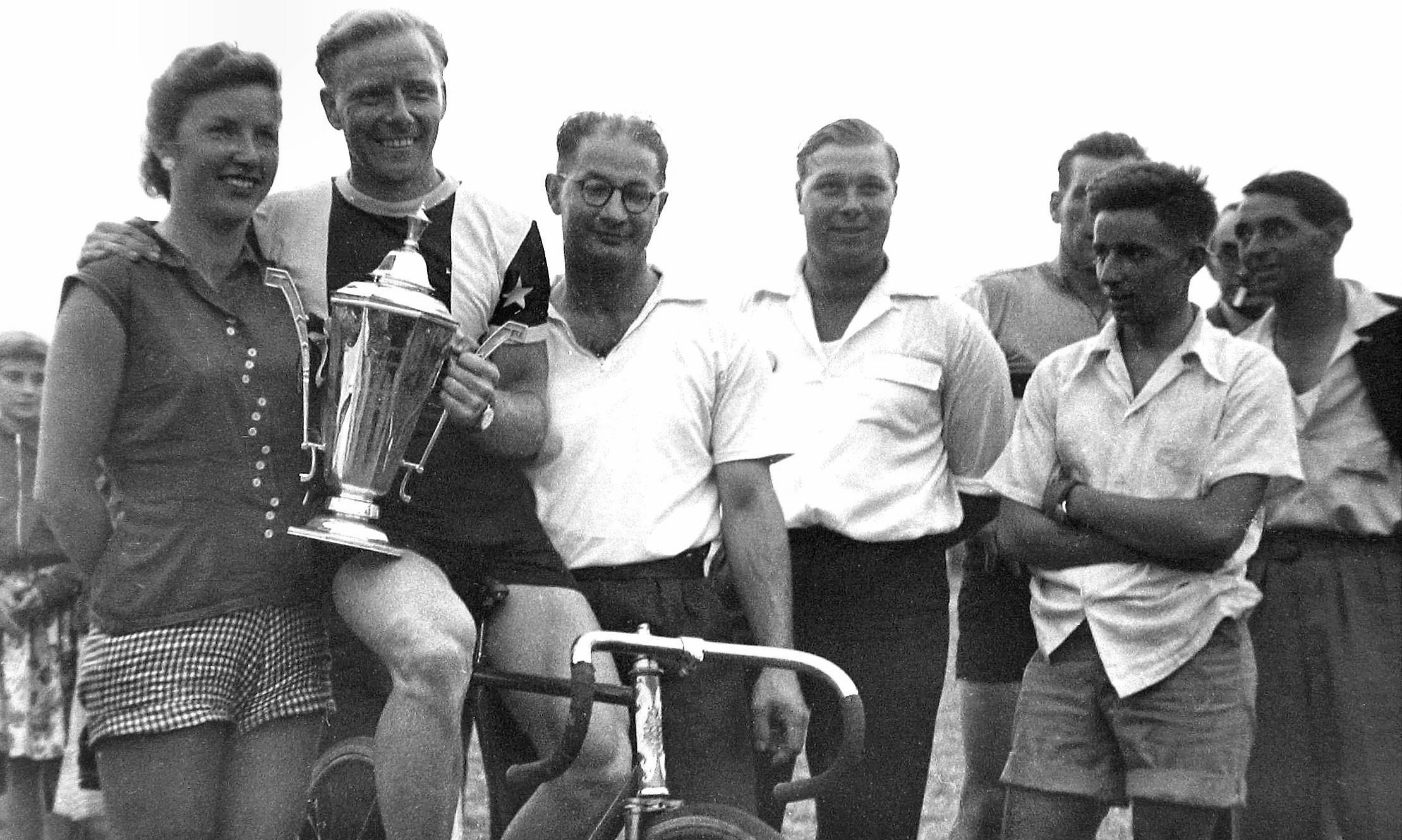Querée Brothers (Cycle Engineers)
Posted: Sunday 23rd August 2020
My first visit to the Querée cycle shop at 130 School Road, Moseley, Birmingham was in 1947. In those post war years finding new 27″ high pressure tyres was very difficult and most Saturdays were spent riding round to all the cycle shops searching for these elusive items. A fellow cyclist at one of the shops, learning of my search, asked if I had “tried the new shop” at the Kings Heath end of School Road. I set off at once and found this new, freshly painted but quite small shop open for business and manned by Berkley and Winter Querée. I did not obtain any tyres but I did acquire, gradually, two new friends.
The shop was, in fact, the front part of an end terraced house and had previously been a greengrocers. Berkley and Winter partitioned off a small area for customers to stand whilst being served, the remaining part being the workshop. Some idea of the size of the establishment can be gained when I mention that four customers at once comfortably filled the waiting area, any more than this involved a complex set of chess–like moves to allow the shop door to be opened.
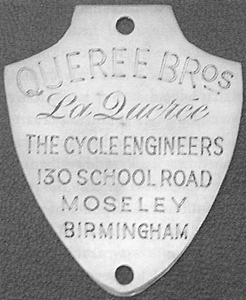
Despite its small size the shop soon attracted the keen lightweight and racing types and Saturdays in the summer months would see a mouth watering selection of bikes cluttering up the hardstanding in front of the shop as the riders made their purchases or just chatted. Fortunately both Winter and Berkley were very easy going and amiable characters with a very dry sense of humour and never seemed to mind the premises being taken over in this way although I sometimes wonder if the presence of all these hard riders did not perhaps deter the occasional “normal” cyclist wishing to buy a lamp battery or some such item.
My first “racing” cycle had been a Raleigh purchased second hand. It was painted red, had nickel plated dropped bars and stem, single fixed wheel and a radial spoked front wheel which I did not notice until I got the bike home and was examining it more closely. I thought I had been sold a bike with a duff wheel until someone explained that this was an accepted method of spoking.
By the time I discovered the Querée shop I had graduated to a rather fine Dawes frame in pale green lustre with chrome plated front forks. This was a sixteenth birthday present and I fitted it out with suitable equipment including Reynolds bars and stem, Harden hubs with Dunlop steel 27” rims, G.B. brakes and a Williams C34 chainset. This was a good, responsive machine but by this time the Querée Brothers had started building their own frames which, after testing, they were happy to produce for customers. These were titled “La Querée”. The frames were silver soldered and had hand cut lugs and distinctive little features in the form of hand made pump pegs and seatstay tops. Most made use of transfers for the head and down tube but some had aluminium head badges and a few had brass head badges and the words “La Querée” in brass letters soldered into place which made the frames very distinctive. These brass items were costly to make and very time consuming to fit so they were soon discontinued. Suddenly the Dawes had lost its charm.
I was now looking for a more “gen” machine but could not afford a new La Querée but, as Winter was building himself a new frame, the bike he was using was available for sale. This was a yellow Cusworth grass track bike on wood sprints with a very narrow, red, Constrictor tub on the front wheel. This was narrower than standard because it had started life as a 26” and Winter had warmed it up in the oven until it was pliable enough to stretch onto the 27” rim of the Cusworth, I had no fear of it rolling off! The bike also had a 13” bottom bracket height and could be cranked over on fixed around corners with no worries about the pedal hitting the deck. I think I paid £8.00 for this bike and paid for it at 10/- per week.
By the following year (1949) I was better off financially and this state of affairs coincided with the appearance in the Querée shop window of an all chrome La Querée track frame with purple flam. fade round the bottom bracket. I think this had been built for a customer who had then not gone through with the transaction. As the frame was my size (23”) I jumped at the chance to purchase my first La Querée. The frame was soon fitted with Chater Lea chainset and pedals, Conloys on large flange Airlights, deep drop Bailey steel bars on a Major Taylor and a suitable front brake and it proved to be a delight to ride.
It was common practice in those days to modify the standard Bailey bars by placing them upside down on the floor, standing with both feet on the centre section and heaving upwards on the ends of the bars. This resulted in some interesting bar shapes and was probably the start of my back problems! Some time after this someone offered me another Cusworth frame this time one allegedly, built for six-day board racing. It had a 37½” wheelbase and the crank touched the tyre when the bars were turned which made life interesting when using the bike on the road. The frame was finished in bright red with nickel plated front forks, head and rear triangle and it was like riding a pneumatic road drill.
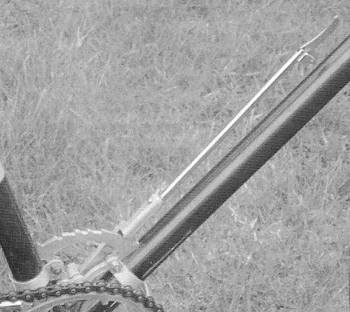
I continued to ricochet around the country on these assorted track irons but then came the chance to purchase a La Querée road frame so the Cusworths were both sold to fund this new purchase. Actually it was not new as it was Winter’s machine and he was building himself another but it was just what I wanted and I equipped it with Conloys on Gnutti Q/R hubs, Gnutti steel chainset, Chater Lea pedals, Brooks B17 Narrow saddle, Simplex 5 speed, South of France bars on steel Reynolds stem and San Giorgio brakes (neat but ineffective). Bluemels transparent mudguards were fitted for use in the wet season (Summer).
Before WW2 Berkley had been a motorcycle mechanic and had equipped his pedal cycle with two modified twist grips one to control the three speed Sturmey Archer hub and the other the front changer. Some time later Berkley sold this cycle to a man who came up from Southampton to collect it and set off to ride it back there; he may have arrived by now!
With the cycle shop in operation the brothers began experimenting with their own design of gear mechanism which worked well but which they could not afford to produce. To work with this gear they had also designed a positive stop gear lever which they could produce “in house” and as they were now on with an updated version I was able to purchase one of the original type they had been using themselves. This early version had an alloy quadrant mounted by three alloy clips round the seat and down tubes just above the bottom bracket (see image).
From the pivot point an alloy and steel lever projected upwards to a convenient height and had a small spring loaded trigger at its top. Indents in the top of the quadrant located each gear position as the lever was moved backwards from the down tube towards the seat tube and, to go back through the gears, the trigger could be flicked to move one step at a time or, by holding the trigger, the lever could be moved in one sweep over all five gears. Used in conjunction with the Simplex of the day this was a superb gear change.
The later version of the gear levers used just the arc of the quadrant bolted to lugs silver soldered to the seat and down tubes with a separate lug for the lever pivot. The base of the lever was now an alloy casting with a chrome plated tube leading to the trigger although I do have an all steel version that Winter was experimenting with. Before fitting it to my road bike I had the frame re-enamelled in green lustre with a candy floss pink (!) panel on the seat tube. With polished brass letters and head badge the machine looked superb. It had been my intention to keep this machine until I was too old to ride any more, but in my later Morgan three wheeler years I lent the bike to a friend of mine who was in need of transport, but it was stolen from where he kept it.
Fortunately the bike was in fixed wheel form when I lent it and I had the Querée lever and the Simplex mechanism safe at home. Shortly after the shop opened a German couple who had lived in this country since before the war offered the brothers a pair of Siddell and Naumann ‘his and her’ cycles. These had been made in Dresden and they had brought them over when they came to live here. The brothers purchased the machines and used them to ride from home to the shop and back each day including through the terrible winter of 1947. The bikes had the wheelbase of a bus, yellow painted steel rims with 2″ balloon tyres, a Torpedo back pedal brake and a cotterless steel chainset. They also boasted a front brake which, when used, pushed a steel pad down onto the front tyre but as the sudden use of this item resulted in impromptu flying lessons these were soon removed.
After the brothers built their own machines the German bikes were put out to pasture and I bought the gents bike and had lots of fun with it as a winter “cramper”. I still have it. I was invited in 1952, by the King of England,to play at soldiers and I did this so well that National Service was increased from eighteen months to two years. Whilst defending the nation I had a rush of blood to the head and purchased a Hetchins “curly” track bike but this proved to be very unresponsive compared to my previous machines so it was sold on with no regrets.
After National Service I drifted into motorbikes and Morgans but still retained an interest in cycling and dropped into the shop to chat to Berkley and Winter from time to time. Life followed the usual pattern of work, marriage and raising two sons and I enjoyed buying bikes for the boys and teaching them to ride. As they got older Nicholas became keen on throwing himself out of aeroplanes in delayed parachute drops but my elder son, Jonathon, became more interested in cycling and joined the Birmingham C.C. As a result my wife Sue, and myself found ourselves marshalling and “pushing off” at Club events and my interest in bikes was renewed.
I decided to look for a bike of the type I had known when I was young and soon joined the Veteran-Cycle Club. I was fortunate enough to find a La Querée 23″ frame which I had re-enamelled in blue lustre with green head tube and seat tube panel and took great pleasure in fitting my Simplex gear and the Queree gearlever. I still had some Conloys, S.O.F. bars etc and was soon back on the road.
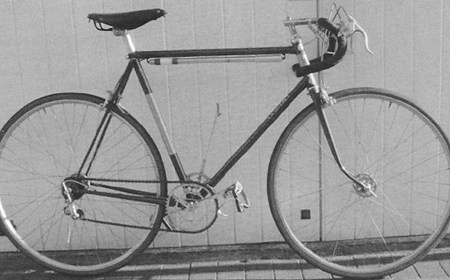
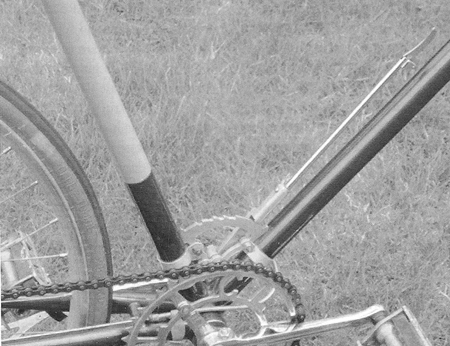
Later on I found another La Querée of the right size for Sue and we now have two “brass letter” machines in our collection. During my “second time around” cycling period I have ridden many bikes and tandems including Joe Cooke, Granby, Rotrax, Jack Taylor, Paris, Bates, Hetchins (yes I bought another, ten times better than the first one), Coppi-Fiorelli, Bianchi, Frejus, Benotto, Cinelli, etc but whilst some ride as well as the L.Q’s, none ride better. I feel privileged to have known and ridden with the Querée’s.
Winter Querée had the ability to ride at a pace that was fast yet effortless and appeared to go along the flat and up or down hills at the same speed. He was of slight build, had dark curly hair, was well tanned and would not have looked out of place in the Tour de France. Berkley had a more casual approach to riding and was always willing to stop and aim his Baldinette 35mm camera at something which attracted his attention. I have already mentioned the dry sense of humour. On one occasion Berkley and I were riding through Henley in Arden and, feeling ravenous, looked for somewhere to eat. The only place open was a very chintzy tearoom. We ordered a selection of sandwiches which, when they arrived, were very thin dainty little crustless triangles. We regarded these in silence for a few moments and then Berkley said “we had better not sneeze Lol”. Happy days.
Posted: Sunday 23rd August 2020
This article appears in the following categories.
Upcoming Events
Whether you are looking for a gentle social meet up, or a 100-mile ride browse the community’s upcoming events and plan your next weekend outing.
